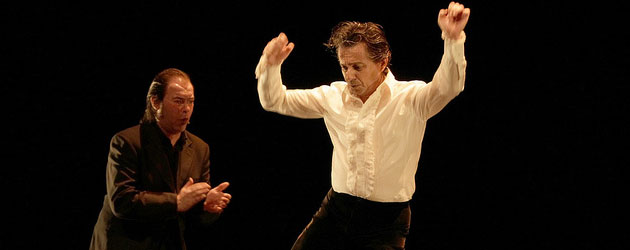Texto: Estela Zatania
Fotos: JeanLouis Duzert
Thursday, January 17th, 2013. 8:00pm. Teatro de Nimes (France)
THE ECOLOGICAL DANCING OF JAVIER BARÓN
Nowadays flamenco often reaches us prepackaged in virtual styrofoam modules which end up littering the mental landscape once they have ceased to be useful. They tell us it’s “fresh” flamenco, but the freshness is as ephemeral as that of yesterday’s bread. Because that which is truly fresh requires no packaging at all. Nor does Javier Barón’s dancing require staging or a script or even palmas. And that’s just how pared-down the dancer from Alcalá came to the Theater of Nimes last night. Even the simple crisp title of the show seems to mock the over-production of so many other shows: “Barón”.
Javier’s dancing generates no waste. No movement is extraneous. This dancer is not from the school of grimaces and karate chops, nor does he punish the floor with his feet. Why should he, if he’s able to summon the flamenco spirits with such ease? Wrapped in the energy of compás and cante, he is the calm at the eye of the storm.
The long bulerías he uses to open is pure art and inspiration. Seemingly discreet, intrinsically powerful. Like the dancing of those old people we’ve all seen who, with a single finger movement or glance, manage to convey universal truths. But it’s not easy to say a lot with little; that beautiful ability of insinuation is not within everyone’s reach. It’s an approach to dance that does not depend only on strength and stamina, but on intelligence, good taste and extreme artistic sensitivity. Watching Javier Barón dance, you are learning to dance at every moment. The clarity of his moves and the sincerity of his personality add up to the most eloquent flamenco expression. Compás itself takes shape right before your eyes.
After the bulerías, singer David el Galli interpreted mining cante accompanied on guitar by Juan Campallo. Javier then returned to do tangos in taranto key with the cajón of José Carrasco, with styles of la Repompa and Granada, courtesy of David who is singing better than ever despite having had a few problems with his voice on this occasion due to a cold. Few dancers not from Granada manage to find as much inspiration in four-quarter time as in the 12-beat compás of bulerías and soleá, and Javier also had a hard time matching the level of the opening bulerías, although he never abandoned his sober concise style.
An unnecessary percussion solo, and then a sweetly retro guitar solo of granaína interpreted by Juan Campallo, winner of the Bordón Minero in 2007, give Barón time to rest before returning for a third dance which is prologued by Galli’s trillas. Alegrías, mirabrás and alegrías de Córdoba melt into siguiriyas and martinete. The excellence of the bulerias is not surpassed, but we were there to witness that perfect testimony to the exquisite flamenco quality of Javier Barón’s dancing.
The era of lavish funding for flamenco is gone. Thanks to artists like Barón, not even the economic crisis can diminish the power of this artform.
